
Lace is a delicate fabric made of yarn or thread in an open weblike pattern, made by machine or by hand. Generally, lace is split into two main categories, needlelace and bobbin lace, although there are other types of lace, such as knitted or crocheted lace. Other laces such as these are considered as a category of their specific craft. Knitted lace, therefore, is an example of knitting. This article considers both needle lace and bobbin lace.

Bobbin lace is a lace textile made by braiding and twisting lengths of thread, which are wound on bobbins to manage them. As the work progresses, the weaving is held in place with pins set in a lace pillow, the placement of the pins usually determined by a pattern or pricking pinned on the pillow.

Kirov, formerly known as Vyatka until 1934 and as Khlynov (Хлы́нов) from 1457 to 1780, is the largest city and administrative center of Kirov Oblast, Russia. It is situated on the Vyatka River in European Russia, 896 kilometres (557 mi) northeast of Moscow. Its population was 468,212 in 2021, up to roughly 750 thousand residents in the urban agglomeration.

Freehand lace is a bobbin lace that works directly on the fabric of the lace pillow without using a pricked pattern. Very few pins are needed for this technique
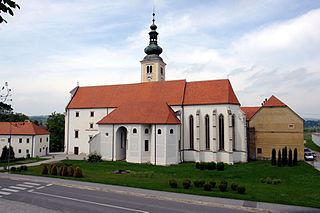
Lepoglava is a town in Varaždin County, northern Croatia, It is located 32 km southwest of Varaždin, 7 km west of Ivanec, and 22 km northeast of Krapina.
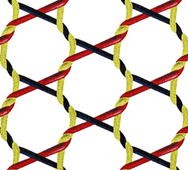
Bobbinet tulle or genuine tulle is a specific type of tulle which has been made in the United Kingdom since the invention of the bobbinet machine. John Heathcoat coined the term "bobbin net", or bobbinet as it is spelled today, to distinguish this machine-made tulle from the handmade "pillow lace", produced using a lace pillow to create bobbin lace. Machines based on his original designs are still in operation today producing fabrics in Perry Street, Chard, Somerset, UK.

Brussels lace is a type of pillow lace that originated in and around Brussels. The term "Brussels lace" has been broadly used for any lace from Brussels; however, strictly interpreted, the term refers to bobbin lace, in which the pattern is made first, and the ground, or réseau added, also using bobbin lace. Brussels lace is not to be confused with Brussels point, which is a type of needle lace, though sometimes also called "Brussels lace".
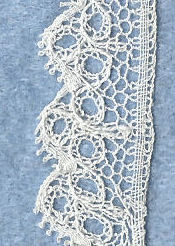
Bucks point is a bobbin lace from the South East of England. "Bucks" is short for Buckinghamshire, which was the main centre of production. The lace was also made in the nearby counties of Bedfordshire and Northamptonshire. Bucks point is very similar to the French Lille lace, and thus is often called English Lille. It is also similar to Mechlin lace and Chantilly lace.

Torchon lace is a bobbin lace that was made all over Europe. It is continuous, with the pattern made at the same time as the ground. Typical basic stitches include whole stitch, half stitch, and twists, and common motifs include spiders and fans. Torchon lace was notable historically for being coarse and strong, as well as consisting of simple geometric patterns and straight lines. It did not use representational designs, for the most part.
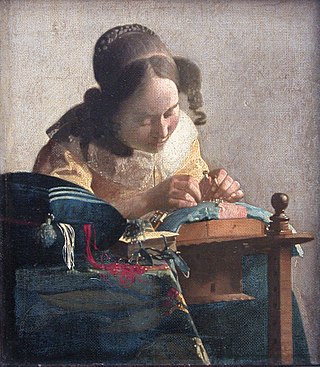
The Lacemaker is a painting by the Dutch artist Johannes Vermeer (1632–1675), completed around 1669–1670 and held in the Louvre, Paris. The work shows a young woman wearing a yellow bodice, holding up a pair of bobbins in her left hand as she carefully places a pin in the pillow on which she is making her bobbin lace.

Battenberg lace is a type of tape lace. It is of American origin, designed and first made by Sara Hadley of New York. This American lace was named either in honor of the wedding of Princess Beatrice, Queen Victoria's youngest daughter, to Prince Henry of Battenberg, or from [sic] the widowed Princess Beatrice. It is made using bobbins and needles, or just needles alone.The original Battenberg lace used just one stitich: buttonhole picot. Other stitches that were later used include flat wheel and rings or "buttons".
Yak lace refers to a coarse bobbin lace in the guipure manner, typically made from wool. It was mainly made in Oxfordshire, Buckinghamshire and Northamptonshire in imitation of Maltese and Greek laces. While the name suggests the lace is made using yak hair, it can be made of any wool or worsted yarn. An example of yak lace in the Pitt Rivers Museum collection illustrates the Torchon style motifs common in this lace.

Bedfordshire lace is a style of bobbin lace originating from Bedfordshire in the 19th century, and made in the English Midlands lacemaking area. It was worked as a continuous width on a bolster pillow. It is a guipure style of lace.

Metal lace describes a type of lace made from metal or metallic threads, such as gold, silver, or copper. The designs can be worked on a textile ground, or the lace can completely be made from metallic threads. It is mainly used as an embellishment for military uniforms, fashionable, ceremonial and theatrical dress, and ecclesiastical textiles.

Maltese lace is a style of bobbin lace made in Malta. It is a guipure style of lace. It is worked as a continuous width on a tall, thin, upright lace pillow. Bigger pieces are made of two or more parts sewn together.

Part lace or sectional lace is a way of making bobbin lace. It characterises various styles, such as Honiton lace or Brussels lace.
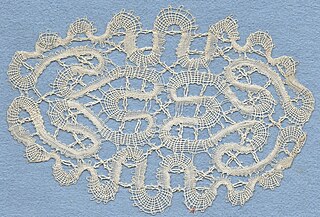
Bobbin tape lace is bobbin lace where the design is formed of one or more tapes curved so they make an attractive pattern. The tapes are made at the same time as the rest of the lace, and are joined to each other, or themselves, using a crochet hook.

Mesh grounded lace is a continuous bobbin lace also known as straight lace. Continuous bobbin lace is made in one piece on a lace pillow. The threads of the ground enter motifs, then leave to join the ground again further down the process, all made in one go. This is different from part lace, where the motifs are created separately, then joined together afterwards.

Ipswich lace is a historical fashion accessory, the only known American hand-made bobbin lace to be commercially produced. Centered in the coastal town of Ipswich, Massachusetts north of Boston, a community of lacemaking arose in the 18th century. Puritan settlers to the area likely made and wore lace as early as 1634, because Sumptuary laws from the early colonial records indicate this activity. In fact, the earliest known record of the act of lacemaking in the region comes from a court case in 1654 associated with the home of Governor John Endicott. An indentured servant in the household accused the governor's son Zerubbabel with assault, which occurred while she was working at her lace cushion. Earliest known records of the commercial production indicate that lace produced by local women was used to barter for goods in the 1760s, as denoted by ledger account books belonging to local merchants. These laces were sold in the region from Boston to Maine.

Milanese bobbin lace is a textile used as a fashion accessory or a decorative trim, first becoming popular in the 17th and 18th centuries in Milan. Lacemaking was an important economic activity in Northern Italy, besides touching on social status matters as well as being a culturally significant art form. The earliest versions of the lace consisted of the tape mostly filling the space. Typical characteristics of Milanese bobbin lace are scrolls made with curving clothwork tapes and floral motifs, and sometimes also consisting of human or animal figures. Sometimes needle lace techniques were combined with the bobbin lace pieces to create the final product.































